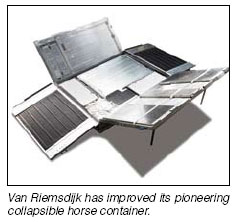
Van Riemsdijk has seen a big surge in demand in the last year or so for horse pallets, with airlines around the world gearing up to cope with anincrease in this type of traffic.
“With the global economy booming, horse racing seems to be peaking,” says Thijs van Riemsdijk, sales director at the Dutch container manufacturer. “Demand is coming from right across the globe, from America to Europe to Asia.” Customers include Japan Airlines and various Middle Eastern carriers.
 Acknowledged experts in the area, van Riemsdijk unveiled a revamped horse container range late last year, including a number of improvements designed to promote animal welfare. For example, its horse containers now have thicker floors, so the horses cannot feel the rollers beneath. They also have better noise insulation, fewermoving parts, and are easy to repair.
Acknowledged experts in the area, van Riemsdijk unveiled a revamped horse container range late last year, including a number of improvements designed to promote animal welfare. For example, its horse containers now have thicker floors, so the horses cannot feel the rollers beneath. They also have better noise insulation, fewermoving parts, and are easy to repair.
The company has also improved on its pioneering collapsible horse container, first introduced in 1996. The latest model collapses to a height of 41 centimetres, as opposed to 29 centimetres for its predecessor, meaning only four can be got onto a lower deck position as opposed to five previously. But Thijs van Riemsdijk says the new version has many welfare improvements, including a greater wall thickness, and a steel divider between groom and horse. “It is altogether a different proposition – much stronger,and much easier to use,” he says.
As well as horse containers, the company has also seen a strong demand for seat pallets in the past year or two, mainly from military customers. These enable flexible use to be made of aircraft, with passenger seating installed in part of it for a flight, and then removed to allow a full cargoload for the next.
Van Riemsdijk says the pallets are especially useful for troop movements and for humanitarian work after natural disasters. The company has made them for aircraft as varied as the A300, A310, 707, 727, 737 and 747. Van Riemsdijk’s range of standard maindeck cargo containers has also been revamped recently, the fruits of a joint project it did with TNT a few years ago. This focused on areas such as repairability, and keeping the total cost of ownership low. As a result, van Riemsdijk has introduced new extrusions and other smart features on itscontainers.
Though its containers are now available with panels made of modern composite materials, Thijs van Riemsdijk says demand for this has been relatively limited so far, however.“There are a number of interestingmaterials out there, including Kevlar,but the cost tends to be a barrier,”he says.
Van Riemsdijk produced an all-composite container in 1998, but it was not a market success. “The majority of customers still prefer alumnimium,” van Riemsdijk says. – Peter Conway









